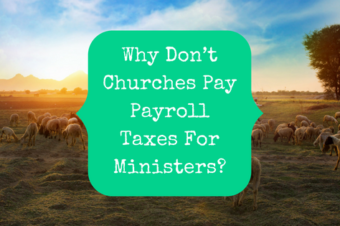
When it comes to Medicare, most pastors don’t really understand how it works. Unfortunately, this is one situation where ignorance can really hurt you. Here are the basics of Medicare and what you can do now, even if you’re still young, to save a lot of money.
Medicare, like Social Security, is one of those things all Americans talk about but really don’t understand. It’s a major part of every American’s future (if we make it to age 65), yet no one takes the time to understand it until it’s time to enroll.
Do you know the difference between Part A and Part B?
Do you know which has a flat fee and which is often free?
Do you know how old you have to be to enroll?
Do you know what happens if you don’t enroll when you’re supposed to?
If you know the answers to those questions, you must already be on Medicare. (If not, let me know because you are one rare bird.)
If your response to those questions was, “I have no idea what you’re talking about,” then you’re normal. Read on. This is important information to know. Even if you’re too young to be able to imagine being 65, understanding Medicare can help you strategically plan and save a lot of money when you do reach that age.
What Is Medicare?
Medicare is the federal government’s health insurance plan for Americans over age 65 and some people with disabilities or end-stage renal disease. It is broken down into four parts, named alphabetically.
Medicare Part A
This is your hospital insurance. Medicare Part A covers things like hospital care, skilled nursing facility care, nursing home care, hospice, and home health services.
Most Americans don’t have to pay for Medicare Part A, but a lot of pastors do. In order to receive premium-free Part A, you need to have paid into Medicare for at least 10 years. Medicare taxes are bunched in with Social Security taxes as a part of your payroll taxes. So, if you opted out of Social Security, you haven’t been paying into the system and may not be eligible for premium-free Part A.
It is important to note that you are still eligible for Medicare and can get Part A coverage, you’ll just have to pay for it. Like Social Security benefits, Part A coverage is earned through accumulating credits. You can read more about that here.
To get premium-free Part A, you need to have earned 40 credits, which is about 10-years’ work. (You can earn up to 4 credits a year.) If you have earned less than 30 credits, you will have to pay full price for Part A, which is $422 in 2018. If you earned between 30 and 39 credits, you get it at a discounted rate of $232 for 2018.
Medicare Part B
This is your doctor insurance. Medicare Part B covers your doctor visits, preventive care, and treatments for any health problems (mental and physical) you have. It also covers equipment you may need in relation to your health problems.
Part B costs are pretty uniform. Almost everyone’s premium is $134 for 2018. Some people may get a $4 discount. Others, with high incomes or penalties, have to pay more. If you receive Social Security benefits, your premium will be automatically deducted from them. If not, then you will receive a bill. Part B coverage has a $183 per year deductible. After that is met, you have to pay 20% for some services.
Medicare Part C
Also called Medicare Advantage, Part C is Medicare-approved private health insurance plans that provide all of your Parts A and B coverage in addition to other benefits, such as vision, dental, and prescription drugs. Part C plans have a lot of variability in cost and coverage, unlike the standard Parts A and B plans. Some people find it more cost-effective to purchase a Part C plan while others want the added coverage that they provide. Part C is optional, though, and a lot of people skip it altogether.
Medicare Part D
America’s medicine cabinets are growing, and Medicare Part D is what helps pay for that. It is prescription drug coverage. Unless you have prescription drug coverage under a Part C plan, you will most likely need Part D, though it is not mandatory. Part D plans vary in coverage and cost, which includes the premium, yearly deductible, copayments or coinsurance, costs in the coverage gap, and possibly late enrollment penalties.
Initial Enrollment & Late Penalties
Late enrollment penalties are actually a serious issue when it comes to Medicare. If you don’t enroll in Medicare when the government wants you to, they will punish you.
To avoid penalties, you need to enroll during your initial enrollment period, which is dependent upon your birthday. You can enroll any time during the three months prior to the month that you turn 65, during that month, or during the three months following that month. So, if you turn 65 on January 17, 2019, your initial enrollment period is October 2018 through April 2019. That gives you a 7-month window to get everything in order or you’ll have to wait for open enrollment.
If you don’t sign up for Medicare Part B during your initial enrollment period, you will be penalized. Your premium will be increased by 10% for each 12-month period that you could have had coverage but didn’t sign up for it. So, if you were eligible in September 2016 but don’t sign up until January 2019, your premium will be 20% higher, since there are 2 complete 12-month periods between those dates.
This is not a one-time penalty. Your premium will be increased for the entire duration of your Medicare coverage which will most likely be for the rest of your life. Even if you enroll on time, you can still incur a penalty if you let your coverage lapse by failing to pay your premiums.
How To Save Money On Medicare
So, how do you save money on Medicare? There are two ways:
Earn enough credits for free or discounted Part A.
If you haven’t earned a full 40 credits towards your Medicare coverage, it might be a good idea to try. Even just earning 30 credits will save you $190 a month under the 2018 rates. You can read more about how to do that here. The sooner you get started on this, the better.
Enroll on time and maintain your enrollment.
If you’re under 60, this is just something to keep in mind. But for all you Baby Boomers out there, you need to start planning for this. Get your forms together, do your research, and be ready to enroll during your initial enrollment period. Then don’t forget to pay your premiums!
If you’ve already missed your initial enrollment period (or you’re already on Medicare and would like to make changes to your coverage), NOW is the time to act. Medicare Open Enrollment starts TODAY, October 15, and goes until December 7. If you fail to act, you will have to wait an entire year until the next open enrollment.
So, whether you were supposed to enroll last year or you have decades before the time comes, it is important to understand Medicare and start planning for it. This is one instance where ignorance will cost you. A lot.



